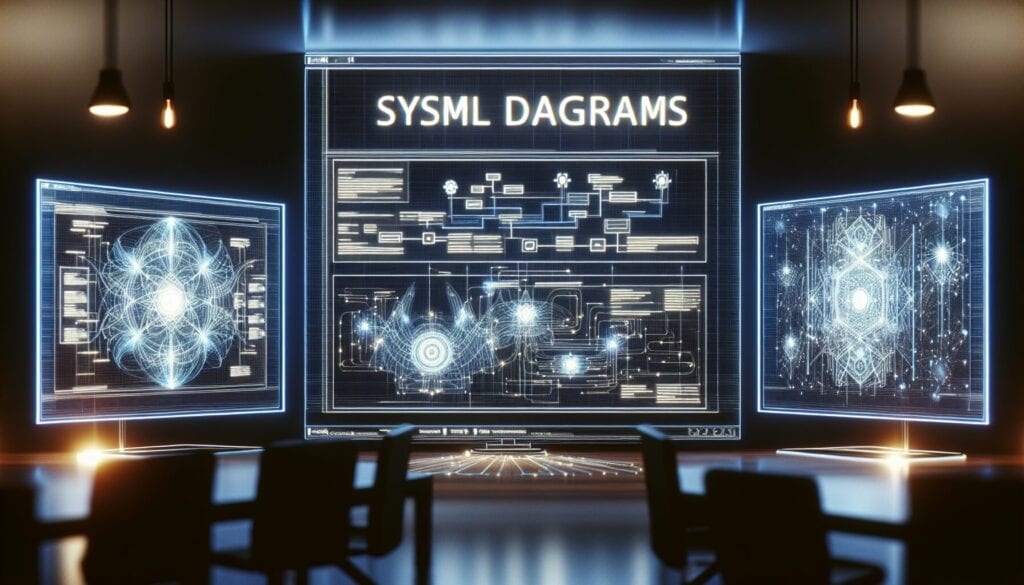To support the specification, analysis, design, verification, and validation of a broad range of systems and systems-of-systems.
- Methodologies: Engineering, Quality
SysML Diagrams

SysML Diagrams
- Agile Methodology, Design for Sustainability, Model-Based Systems Engineering (MBSE), Process Improvement, Project Management, Quality Management, Systems Modeling Language (SysML), Unified Modeling Language (UML), Verification and Validation
Objective:
How it’s used:
Pros
- Provides a standardized way to represent systems; Facilitates communication and collaboration among different engineering disciplines; Supports model-based systems engineering (MBSE); Helps manage complexity.
Cons
- Can be complex to learn and use effectively; Requires specialized modeling tools; May be perceived as overly formal for smaller projects; Potential for 'language bloat' due to its comprehensiveness and UML inheritance.
Categories:
- Engineering, Product Design, Project Management, Risk Management
Best for:
- Modeling and managing complex, multi-disciplinary systems throughout their lifecycle.
SysML diagrams find extensive applications across various industries such as aerospace, automotive, defense, healthcare, and telecommunications, where the design and integration of complex systems are commonplace. During the requirements phase of a project, stakeholders can utilize requirement diagrams to capture and organize user needs, ensuring clarity in what the end product must achieve. The block definition diagram is particularly beneficial in early design stages for representing the system architecture, facilitating discussions among engineers about component interrelations before proceeding to detailed design. Internal block diagrams can then be used in the development phase to illustrate the interactions between components at a deeper level, which can prove invaluable when conducting trade studies and system verification. Parametric diagrams come into play for performance analysis, enabling engineers to evaluate constraints and parameters that define system behavior under various conditions. Typically, a cross-disciplinary team comprising systems engineers, software developers, hardware engineers, and project managers collaborates on these diagrams to ensure that all facets of the design are aligned and that the integration challenges are addressed early on. Utilizing SysML enables model-based systems engineering, which reinforces a holistic view of the project while addressing interdisciplinary requirements, thus enhancing collaboration and reducing the likelihood of costly miscommunications during later stages. The standardization of representations across different teams accelerates the overall workflow, making it easier to share models and documentation through various phases of the system lifecycle, from conceptualization to deployment and maintenance.
Key steps of this methodology
- Define system requirements using requirement diagrams to capture stakeholder needs.
- Create block definition diagrams to represent system elements and their relationships.
- Develop internal block diagrams to illustrate internal system structure and connectivity.
- Construct parametric diagrams to define performance constraints and relationships among system properties.
- Use sequence diagrams to detail interactions and workflows between components.
- Iterate through diagrams as needed to refine and validate system models continuously.
- Integrate and verify models across different engineering disciplines to ensure alignment.
- Conduct reviews and assessments to evaluate system design and functionality against requirements.
Pro Tips
- Utilize cross-discipline collaboration sessions to review SysML models, ensuring alignment and addressing discrepancies early in the design phase.
- Leverage the power of parametric diagrams to quantify and validate system performance criteria, providing tangible metrics that guide design decisions.
- Integrate version control tools with your SysML models to track changes over time, facilitating better management of systemic evolution and decision-making processes.
To read and compare several methodologies, we recommend the
> Extensive Methodologies Repository <
together with the 400+ other methodologies.
Your comments on this methodology or additional info are welcome on the comment section below ↓ , so as any engineering-related ideas or links.
Historical Context
1980
1980
1986
1987
1990
1990
1990
1980
1980
1986
1986
1987-03
1990
1990
1992
(if date is unknown or not relevant, e.g. "fluid mechanics", a rounded estimation of its notable emergence is provided)















Related Posts
METS to Calories Calculator
Meta-Analysis
Message Mapping
Mental Model Diagrams
Maximum Acceptable Pushing and Pulling Forces
Material Requirements Planning (MRP)